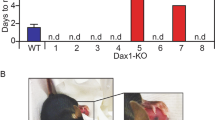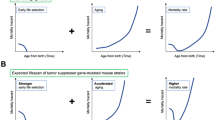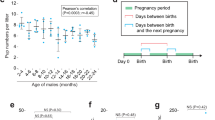Abstract
THE testicular feminisation syndrome in affected XY male mice is the result of the action of the X-linked Tfm gene1, which causes a failure of target organs to respond to androgen. The question arises whether genetic females affected with the gene would be reproductively abnormal in any way. Androgen is produced in the normal mouse ovary; its functional significance is not understood but it has been claimed that a response to androgen is essential for ovulation and mating2. If so, then females homozygous or hemizygous for the Tfm gene (Tfm/Tfm or Tfm/0) might be unable to reproduce. Ohno et al.3, have recently described six Tfm/0 female mice which collectively showed remarkably rapid ovarian degeneration, more rapid than in +/0 mice, thus leading to the conclusion that a response to androgen is necessary for normal ovarian function in mice. The fertility of these mice had not, however, been tested. We here report results with two Tfm/0 mice, both of which proved to be fertile and produced litters.
This is a preview of subscription content, access via your institution
Access options
Subscribe to this journal
Receive 51 print issues and online access
$199.00 per year
only $3.90 per issue
Buy this article
- Purchase on Springer Link
- Instant access to full article PDF
Prices may be subject to local taxes which are calculated during checkout
Similar content being viewed by others
References
Lyon, M. F., and Hawkes, S. G., Nature, 227, 1217 (1970).
Parkes, A. S., and Deanesly, R., in Marshall's Physiology of Reproduction, 3, chap. 30 (edit. by Parkes, A. S.), (Longman, Toronto, 1966).
Ohno, S., Christian, L., and Attardi, B., Nature new Biol., 243, 119 (1973).
Russell, L. B., in Effects of Radiation on Meiotic Systems (International Atomic Energy Agency, Vienna, 1968).
Lyon, M. F., and Hawkes, S. G., Genet. Res., 21, 185 (1973).
Brambell, F. W. R., in Marshall's Physiology of Reproduction, 1, part 1, chap. 5 (edit. by Parkes, A. S.) (Longmans, Toronto, 1956).
Peters, H., and Borum, K., Int. J. Rad. Biol., 3, 1 (1961).
Jones, E. C., and Krohn, P. L., J. Endocr., 21, 469 (1961).
Ohno, S., Christian, L., Attardi, B. J., and Kan, J., Nature new Biol., 245, 92 (1973).
Cattanach, B. M., Perez, J. N., and Pollard, C. E., Genet. Res., 15, 183 (1970).
Author information
Authors and Affiliations
Rights and permissions
About this article
Cite this article
LYON, M., GLENISTER, P. Evidence from Tfm/0 that Androgen is Inessential for Reproduction in Female Mice. Nature 247, 366–367 (1974). https://doi.org/10.1038/247366a0
Received:
Issue Date:
DOI: https://doi.org/10.1038/247366a0
This article is cited by
-
Gender disparity in survival of early porcine fetuses due to altered androgen receptor or associated U2 spliceosome component
Scientific Reports (2023)
-
Polycystic ovary syndrome induced by exposure to testosterone propionate and effects of sympathectomy on the persistence of the syndrome
Reproductive Biology and Endocrinology (2017)
Comments
By submitting a comment you agree to abide by our Terms and Community Guidelines. If you find something abusive or that does not comply with our terms or guidelines please flag it as inappropriate.



